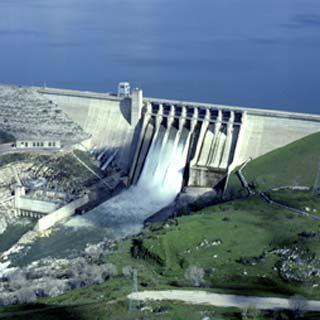In a sign of growing drought in California, state officials recently took the unusual step of loosening environmental water quality rules in hopes of protecting salmon in the Sacramento River.
The move illustrates how drought forces difficult trade-offs in modern-day California, where water supplies are stretched to the limit even in normal years.
The problem is that Shasta Lake, the largest in the state, risks running out of cold water before salmon migrate upriver from the ocean for their fall and winter spawning runs. If that were to happen, the salmon population, which has rebounded strongly from several years of sharp declines, could face lethal warm temperatures in the river.
The U.S. Bureau of Reclamation, which owns Shasta Lake, has a duty under the Endangered Species Act to preserve a so-called “cold water pool” in the reservoir to protect spawning salmon in the Sacramento River.
But, because of the unusually dry winter in California and Reclamation’s own operating laws, that cold water pool already has been rapidly depleted, raising concerns that 2013 could turn out to be another deadly year for salmon.
So on May 29, the State Water Resources Control Board, which governs water rights in California, loosened certain water quality rules to help.
One change allows Reclamation to meet a 56-degree temperature standard, crucial to salmon, at a location in the river in Anderson that is seven miles farther upstream from the usual location.
“That’s our best estimate of where we can maintain that temperature for the entire summer and into the fall,” said Ron Milligan, operations manager for Reclamation’s Central Valley Office. “We don’t have nearly the cold water pool in Shasta that we would typically like to see.”
The change means Reclamation can release less cold water from Shasta Dam through the summer, allowing it to stretch its supply into fall. It also means about seven miles of potential spawning habitat probably will be too warm.
State and federal wildlife officials supported the change, partly because the seven miles of river at issue are not heavy spawning areas.
Winter-run chinook salmon, an endangered species, are spawning in the river now. An aerial survey two weeks ago found 13 winter-run spawning redds, or nests, in the river. Only one of those was in the seven-mile stretch where the temperature standard no longer applies.
“We are quite concerned” about warmer river temperatures, said Maria Rea, regional supervisor for the National Marine Fisheries Service, which nevertheless supported the change because it stretches the cold water as long as possible. “We could have some serious temperature-related impacts on winter run this year.”
The state board also allowed Reclamation to meet water quality standards in the Sacramento-San Joaquin Delta that apply to a “critically dry” year, one notch worse than the “dry” conditions that had prevailed.
The change also applies to the California Department of Water Resources, which operates the reservoir at Lake Oroville on the Feather River.
Effectively reclassifying the drought situation in this way allows the water agencies to reduce freshwater outflow through the Delta. This means portions of the western Delta will get saltier, because there is less fresh water pushing back against tides from San Francisco Bay.
This may be a problem for some Delta farmers, who draw irrigation water directly from the estuary and often lose crop productivity when the water gets saltier.
The South Delta Water Agency, which serves farmers in a portion of the estuary, objected to this change.
“This could be a horrible summer,” said John Herrick, manager of the agency. “Things are looking really bad, and we’re not even in the middle of a four-year drought. If we’re going to run out of water like this in the beginning of droughts, something’s horribly wrong.”
Herrick fears the cold water Reclamation has been allowed to hold back this summer will simply be diverted from the Delta in the fall to please its irrigation customers in the San Joaquin Valley.
Craig Wilson, who approved the changes as Delta watermaster for the state water board, said he’ll watch to ensure that doesn’t happen.
“It was a really unique circumstance where you had this issue with dueling water quality standards,” Wilson said of the changes. “It was kind of a tough call.”
One reason is that California’s last winter was a trickster. It began wet, with heavy and relatively warm storms in November and December. Under federal water contracting law, the amount of water in those two months was enough to require Reclamation to promise full water deliveries to a certain group of water customers in the Sacramento Valley.
These so-called “settlement” contractors held water rights in the Sacramento River before Shasta Dam was built, so they get first shot at any available water. They began drawing their full allocations from the reservoir this spring, which began to deplete the cold water pool behind the dam well before summer arrived.
Meanwhile, the rest of winter proved to be unusually dry, so the reservoir did not refill at a normal pace. The northern Sierra Nevada watershed, which includes Shasta Reservoir, ended up with the lowest precipitation in 100 years of recorded history for the important January through May period.
The resulting problems extend to all of the state’s reservoirs, including Folsom Lake in the Sacramento area. Folsom also must preserve a cold water pool to protect salmon and steelhead in the American River – an even more challenging task because it is much smaller than Shasta.
The two rule changes together may allow as much as 200,000 acre-feet of water to be preserved behind dams. But that does not mean the worries are over.

